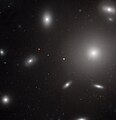Файл:NGC 4874 HST.jpg
Перейти до навігації
Перейти до пошуку

Розмір при попередньому перегляді: 578 × 600 пікселів. Інші роздільності: 231 × 240 пікселів | 463 × 480 пікселів | 740 × 768 пікселів | 987 × 1024 пікселів | 1973 × 2048 пікселів | 3864 × 4010 пікселів.
Повна роздільність (3864 × 4010 пікселів, розмір файлу: 5,95 МБ, MIME-тип: image/jpeg)
Історія файлу
Клацніть на дату/час, щоб переглянути, як тоді виглядав файл.
| Дата/час | Мініатюра | Розмір об'єкта | Користувач | Коментар | |
|---|---|---|---|---|---|
| поточний | 11:55, 20 вересня 2011 |  | 3864 × 4010 (5,95 МБ) | Jmencisom |
Використання файлу
Така сторінка використовує цей файл:
Глобальне використання файлу
Цей файл використовують такі інші вікі:
- Використання в ar.wikipedia.org
- Використання в arz.wikipedia.org
- Використання в ast.wikipedia.org
- Використання в az.wikipedia.org
- Використання в be.wikipedia.org
- Використання в ce.wikipedia.org
- Використання в cs.wikipedia.org
- Використання в de.wikipedia.org
- Використання в diq.wikipedia.org
- Використання в en.wikipedia.org
- Використання в et.wikipedia.org
- Використання в eu.wikipedia.org
- Використання в fr.wikipedia.org
- Використання в hr.wikipedia.org
- Використання в it.wikipedia.org
- Використання в ja.wikipedia.org
- Використання в kk.wikipedia.org
- Використання в ko.wikipedia.org
- Використання в mk.wikipedia.org
- Використання в nl.wikipedia.org
- Використання в pl.wikipedia.org
- Використання в ru.wikipedia.org
- Використання в sk.wikipedia.org
- Використання в sl.wikipedia.org
- Використання в tt.wikipedia.org
- Використання в uz.wikipedia.org
- Використання в www.wikidata.org
- Використання в zh.wikipedia.org